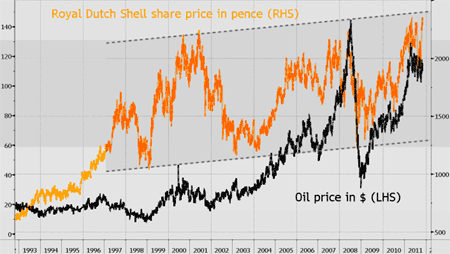Britain’s ‘big oil’ companies were on centre stage last week.
BP, BG Group and Royal Dutch Shell have just reported their third-quarter figures and latest trading statements. This means that lots of UK investors will be poring over the small print, trying to figure out which of the three is the best bet.
So if you want to hold shares in an oil and gas business, which should you choose? Or is there an even better option you can buy elsewhere?
It’s hard to avoid big oil
BP, BG and Shell aren’t just major oil and gas companies. All three firms are so big that they feature within the top ten UK-listed companies. So whether the oil price is going up or down, they’re still key shares for UK investors. Almost everyone with money in the stock market will have a stake in the sector, either directly or via a fund.
Sure, profits made by oil and gas companies are linked to crude costs. But this isn’t a one way street. If the price of the stuff that comes out of the ground drops, that helps these firms’ ‘downstream’ operations. This is where oil-derived products such as plastics are made. In other words, cheaper prices here make it easier to sell higher volumes.
So either way, over the medium term, the oil and gas business will keep dominating the global economy. Such a wide range of industries from chemicals to cars depends on it. That means energy producers are set to stay amongst their countries’ biggest firms.
That applies even when a big oil company has blotted its copybook. BP did that in spectacular style last year with the Gulf of Mexico disaster. This cratered the share price – and no wonder. The cost of trying to repair the damage has since climbed to around $40bn. That’s almost a third of the firm’s market worth.
Yet, BP has climbed by some 55% from its June 2010 lows. It’s still Britain’s fourth-biggest company by market cap. This means that even now, it very much demands investors’ attention.
We looked at the firm last week: Is it time to buy BP again? so I’ll not repeat all the details. To sum up, BP might look cheap on a prospective p/e below seven. But it’s higher risk than it used to be. Restoring the dividend that was axed post-disaster could take a year or two. In the meantime, a yield just over 3.5% seems plenty low enough. So we’d look elsewhere.
Bargains are hard to find
Maybe the ‘quality’ firm in the sector is BG Group. It’s a world leader in natural gas. This is a fuel we reckon has a great future.
In last Friday’s MoneyWeek magazine, my colleague James McKeigue ran the slide rule over the sector. He’s identified several ways of playing natural gas. But James hasn’t included BG in his list. On a current year p/e of 18, with a prospective yield of a mere 1%, I can see exactly why not. Much of the good news has already been factored into the share price. BG shares have at least doubled over the last three years, and I’d not want to chase them higher.
What about the biggest fish of all, the giant Royal Dutch Shell? Just by itself, it accounts for 9% of the FTSE 100 market cap. And the latest figures were good.
In the three months to September, Shell made $7.2bn. This was more than double last year’s number. The statement was fairly upbeat too. The upshot is that Shell is now on a current year p/e of just over eight.
What’s more, the prospective yield is a reasonable 4.7%. All of which looks good news for investors.
But I’d be wary about buying Shell now. Look at this chart:

Source: Bloomberg
The oil price in US dollars is in black. Royal Dutch Shell is in orange. Over the last 15 years or so, Shell has traded in a gently upward sloping range. It’s currently between 1,300p and 2,400p. And the price right now is very much to the top of that range.
In other words, the shares have run ahead while crude has fallen. OK, as explained above, that’s not always bad news for the firm. But the oil price has recently been setting the tone for the share price.
And the higher the latter climbs, the lower the dividend yield. In short, Shell’s yield has now fallen below par compared with much of its recent history.
This suggests you should expect a yield between 5.5% and 6% for holding the stock. In turn, that would mean buying Shell at between 1,800p and 1,950p. You may have to wait, but it should be worth it.
So if the UK big oils don’t quite fit the bill for investors right now, what does? Let’s look across to the eurozone.
A better value alternative
Just over a year ago we recommended Austria’s largest industrial company OMV (AV: OMV). It explores for natural gas and crude oil, refines crude and sells it. In fact, it’s one of the few oil and gas producers whose shares are below their published net asset value (NAV). BP, BG and Shell all trade at above NAV. But OMV’s current p/NAV ratio is 0.79, which means you’re getting €1 of assets for 79c.
OMV shares gained 20% by February 2011. And by early September, they had outrun the overall European market by more than 20% since our tip. But they’ve since been dragged down by the latest turmoil. On a current year p/e of seven and a 4% prospective yield, OMV is now very good overall value again.
Category: Market updates

